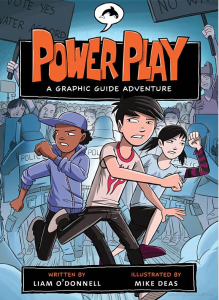Last year, I had the unique chance to use Minecraft with a small group of students who came to me three days a week for literacy support. It was a messy, fun three months and the kids did a lot of writing and researching outside the game, driven by their explorations in the world they were building. Soon, it was June and we all went our separate ways for the summer. I thought we had all just had a fun time while building our reading and writing skills. Two months later, when we returned to school in September, I realised my kids had not stopped playing and they had not stopped learning. They had become Minecraft superfans.
It started on yard duty when two of them rushed up to me.
“Mr. O’Donnell! 1.8 comes out today! Are you excited?”
1.8? What are they talking about? They told me in that way kids can tell you something obscure that you should totally know about. “Minecraft 1.8 update? Endermen? Adventure mode?” Then I was treated to a 15 minute debate between the kids on the merits of the new patch.
Remember, these are students who “don’t read”. And yet, they were versed with the ins and outs of the latest Minecraft patch. Which they had researched and learned about by themselves. During the summer. Think about that.
Many of those Minecraft kids happened to end up in my Grade 5/6 class. Unfortunately, with over 31 kids in the class and one computer in the room, playing Minecraft wasn’t going to happen. But that didn’t stop Minecraft from being a focal point in our classroom.
It started with drawings left on my desk. Like this one:
Then there was the Reading Responses based on Minecraft videos on youtube. And the recess game, where they ran around pretending to mine for diamonds while fleeing creepers. Seriously. It was amazing to watch and totally undocumented (which is best, I think.)
But there was also their Math Journals (note the TNT):
And binders:
In short, my students had Minecraft on the brain. Most had downloaded it and were playing at home. When I apologized to a parent for showing Minecraft to her daughter, she said “Hey, at least it’s not Call of Duty.” Very true.
My students, like me, were spending their evenings in Minecraft building, sharing and learning far beyond what I hoped we could achieve during our weekly classes the previous year. It was amazing.
Sadly, last week was my final week with this class. I am an occasional teacher covering a maternity leave. The students’ regular teacher had decided to come back earlier than planned and Friday was my last day at this school. Among the many amazing cards my students created for me, two of the Minecraft kids gave me the highest honour: they put me in their world of Minecraft.
Here I am, fresh from just killing a creeper (note the gunpowder loot drop):
And here I am wearing a “#1 Teacher” medal, complete with diamond pickaxe and Minecraft toolbar interface:
I bring all this up not to brag (although I am a bit) but to hopefully highlight a point to educators seeking to “gamify” their teaching by using video games in the classroom. Simply adding “quests” instead of assignments, or badges and experience points instead of grades misses the real power of video games as a cultural force in the lives of young (and old) people and a site of situational learning that is key to authentic, student driven learning. Games live on in the minds of kids (and adults) long after we log out. Game worlds, characters and adventures all live within our brains propelling us on in our learning journey. That is the power of games in education. Simply using games because it engages students is doing both games and the students a disservice.
My time actually “teaching” with Minecraft was only 3 months. For the students, their time “learning” in the game carries on today. I am honoured to have had the chance to introduce them to the game. I am amazed at where they have taken their love for Minecraft. And I am excited to see where their confidence, enthusiasm, and yes increased ability to read and write thanks to the game, will take them.
For me, this is the true potential of video games in education.


























…
cool, i like minecraft, too, i hope my teacher sees this and does the same thing you have done
I hope so too Owen! Why not show him or her this post? Better yet, send them to our Minecraft for educators website at GamingEdus.org and they can learn how to get started using Minecraft in school.
cool. i’m in 5th grade now, 11, and i’ve been playing minecraft for 5 years. i’ve always wanted to play minecraft in school